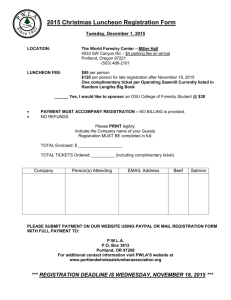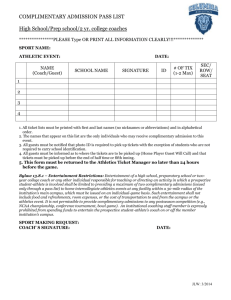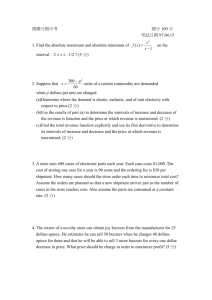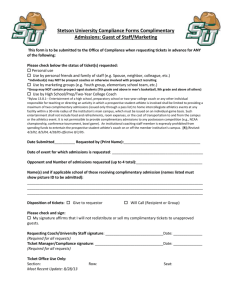why it is impossible to avoid risk 1
advertisement
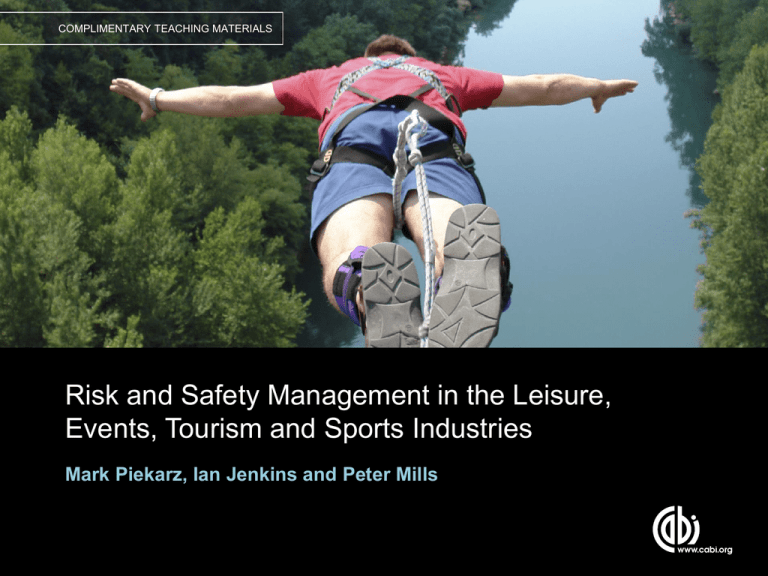
COMPLIMENTARY TEACHING MATERIALS Risk and Safety Management in the Leisure, Events, Tourism and Sports Industries Mark Piekarz, Ian Jenkins and Peter Mills Chapter 1 – The Risk Encounter for the Different Industry Sectors COMPLIMENTARY TEACHING MATERIALS LEARNING OBJECTIVES These relate to the chapter objectives in Chapter 1: • To explain why risk management is important for practitioners to understand. • To explain why managers in different industry sectors, at all levels of management, cannot avoid risk management. COMPLIMENTARY TEACHING MATERIALS INTRODUCTION • Why is risk difficult to avoid for practitioners and mangers in the different sectors? • How does the encounter vary according to the type of work, or the sector? COMPLIMENTARY TEACHING MATERIALS WHAT COMES TO MIND WHEN YOU THINK ABOUT RISK MANAGEMENT? Is it silly rules, bureaucracy, more paperwork and stopping people having fun? This book and series of lecture slides will explain why it is more than this and how it can help managers, not impede them. Source: HSE (2015) COMPLIMENTARY TEACHING MATERIALS WHY IT IS IMPOSSIBLE TO AVOID RISK: OVERVIEW As part of living and business: As part of working practices: • Inherent part of life. • • Inherent part of adventure, • sport and tourism activities. • Essential part of • entrepreneurial activity: Bernstein (1998) - ‘if there is no risk, there is no profit.’ COMPLIMENTARY TEACHING MATERIALS Part of management. Part of the language of problem solving. Risk management is part of legal compliance, health and safety compliance, or part of good corporate governance. WHY IT IS IMPOSSIBLE TO AVOID RISK 1: PART OF LIFE • • • • • • • • • Did you spot it? It’s the stairs! Around the world, thousands of deaths and injuries occur as a result of stairs . Does that mean we should get rid of stairs? Of course not! We tolerate and take the risks because of the benefits having stairs bring (e.g. more living space). The risks are acceptable with the use of control measures such as hand rails and space in steps. The risks vary for different users. We engage with risks every day of our lives, from travelling to work to living in our homes. COMPLIMENTARY TEACHING MATERIALS SPOT THE KILLER IN THIS PICTURE WHY IT IS IMPOSSIBLE TO AVOID RISK 2: PART OF ADVENTURE, SPORT AND TRAVEL • Where would we be if we removed all risk from sport, tourism, adventure? • Control, yes, remove all risk, no! COMPLIMENTARY TEACHING MATERIALS ‘travel’ derives from the French word travail, which means an arduous or painful journey, but one which still brings rewards WHY IT IS IMPOSSIBLE TO AVOID RISK 3: LANGUAGE OF ANALYSIS AND PROBLEM SOLVING ‘…an athlete can make decision to play safe, and perhaps finish 15th, or take a risk which means they could come first, but could also mean they fail to finish or come last.’ Sir Dave Brailsford, the SKY team and Olympic cycling coach who helped athletes win many races and gold medals. His approach, simply put is to encourage risk taking by the athlete to take the risk, whereby it is better to take the risk and fail, than to just play safe. ‘We have to enjoy the risk of the situation,’ said José Mourinho, the Chelsea boss, who had to overcome a 3-1 defeat in the Champions League to progress to the next round. ‘The reasons are not important. The only thing that is important is belief and I believe. My players believe”. They took the risk and did it. … COMPLIMENTARY TEACHING MATERIALS WHY IT IS IMPOSSIBLE TO AVOID RISK 4: REGULATORY COMPLAINCE FOR HEALTH AND SAFETY AND CORPORATE GOOD GOVERNANCE •‘Are the significant internal and external operational, financial, ‘It is a legal requirement for every employer and self-employed person to make an assessment of the health and safety risks arising out of their work. The purpose of the assessment is to identify what needs to be done to control health and safety risks. Regulation 3 of the Management of Health and Safety at Work Regulations 1999. ’ HSO (2015) COMPLIMENTARY TEACHING MATERIALS compliance and other risks identified and assessed on an ongoing basis? These are likely to include the principal risks identified in the Operating and Financial Review. • Is there a clear understanding by management and others within the company of what risks are acceptable to the board?” (FRC 2005) WHO NEEDS TO CONSIDER RISK MANAGEMENT? (SEE FIGURE 1 FOR AN OVERVIEW ON THE NEXT SLIDE) • Deliverers of services (more operational health and safety focus COMPLIMENTARY TEACHING MATERIALS Planners of services (more project and strategic focus) FIGURE 1: AN OVERVIEW OF THE RISK ENCOUNTER • Examples include event project managers, facility managers, entrepreneurs, tour operators, etc. •Examples include coaches, instructors, teachers, tour guides, activity leaders, etc. ROLES •Regulatory compliance •Good business practice •Need for experiential services (services which arouse emotions and are stimulating) •Moral and ethical duty COMPLIMENTARY TEACHING MATERIALS Planners Deliverers Drivers of practice Risk exposure modifers SHAPERS OF PRACTICE •Who is at risk? •Location of activity (e.g. indoors, outdoors, country, level of development etc.) •Level of management (operational, strategic or project) •Sector operated in (public, voluntary, private) WHAT SHAPES THE RISK ENCOUNTER? Drivers of practice: Risk exposure modifiers: • Regulatory compliance; • type of organization; • desire for effective • nature of the clients; management; • size of the stake. • offering services which give satisfaction; • a sense of morality and behaving ethically. See Figure 1 for an overview COMPLIMENTARY TEACHING MATERIALS RISK ENCOUNTER IS ALSO SHAPED BY THE LEVEL OF MANAGEMENT The health and safety level The project management level For many countries, such as the USA, UK and Australia, legislation relating to work or occupational health and safety can mean a legal requirement to engage with some form of risk or hazard assessment exercise. Project Management Institute (PMBOK 2004) argue that risk analysis has become increasingly important in project management. Again, there is no formal legal requirement to engage with risk management in project management, but it is seen as good practice. If projects fail because of failures to identify and manage risk, there could be scope for litigation. The operational management level Related to safety risk management, but involves a broader range of issues, such as which factors can lead to the risks of services being cancelled, or customers receiving a poor quality service. It is intimately related to quality assurance systems. COMPLIMENTARY TEACHING MATERIALS The strategic management level At a strategic level, the need to engage with risk management is embedded in practices and regulations relating to good corporate governance (i.e the rules and regulations which shape how businesses or organizations are managed and directed). There are now regulations which have developed in different countries (e.g the 2002 Sarbanes-Oxely Act (USA), or in the Turnball report (UK)). CONTEXTUALISATION AND APPLICATION TO THE DIFFERENT SECTORS • At the end of the chapter in the book, a variety of examples are given to illustrate how these concepts can be applied to specific industry sectors. • You are encouraged to select the most relevant sector examples related to your teaching and learning needs. COMPLIMENTARY TEACHING MATERIALS CONCLUSION • Risk for people working in the adventure, leisure, event, tourism or sport industries is impossible to ignore. • It is something used at all levels of management. • In terms of variations from around the world, whilst the regulations differ, some of the underlying principles of risk management can be remarkably similar (see Chapter 2 definitions lecture) COMPLIMENTARY TEACHING MATERIALS REFERENCES • • • • • Bernstein, P. (1998), Against the Gods: The Remarkable Story of Risk, Wiley and Sons, Chichester. Handy, C. (1999) Beyond Certainty: The Changing Worlds of Organizations, Harvard Business School, Boston. HSO (2015) Frequently asked questions, available at: http://www.hse.gov.uk/risk/faq.htm (accessed 12 February 2015). FRC (2005) Internal control: Revised guidance for directors on the combined code, available at: https://www.frc.org.uk/getattachment/5e4d12e4-a94f-4186-9d6f19e17aeb5351/Turnbull-guidance-October-2005.aspx (accessed 12 February 2015). PMBOK (2004) A Guide to the Project Management Body of Knowledge, Project Management Institute, Pennsylvania (3rd edition), PMBOK. COMPLIMENTARY TEACHING MATERIALS DISCUSSION QUESTIONS • Identify how many potential hazards and risks you may have been exposed to in one day which could affect your health, finances and sense of wellbeing. • How did you try to avoid or deal with some of these hazards and risks? • Choosing two different sectors of your choice, compare and contrast the need to engage with risk management by examining a range of documents and websites. • For a country of your choice, compare the approaches to risk in occupational health and safety guidelines with strategic corporate governance regulations (see Text Box 1.2 in Chapter 1 for some initial examples). COMPLIMENTARY TEACHING MATERIALS Thank You Name: Email: Dr Mark Piekarz m.piekarz@worc.ac.uk COMPLIMENTARY TEACHING MATERIALS
